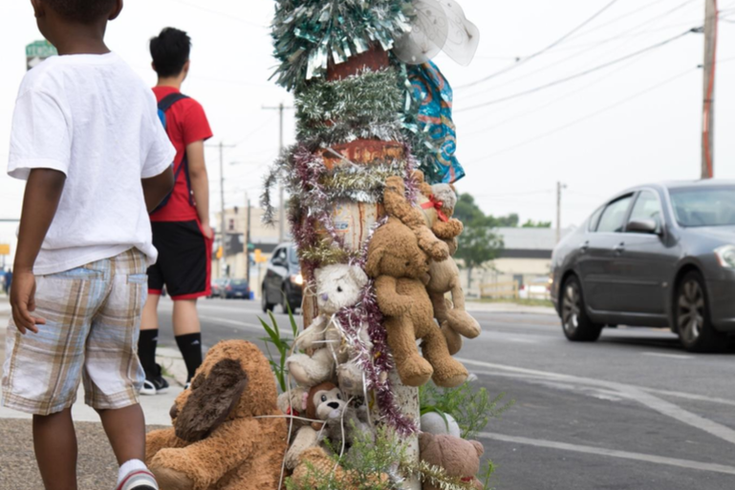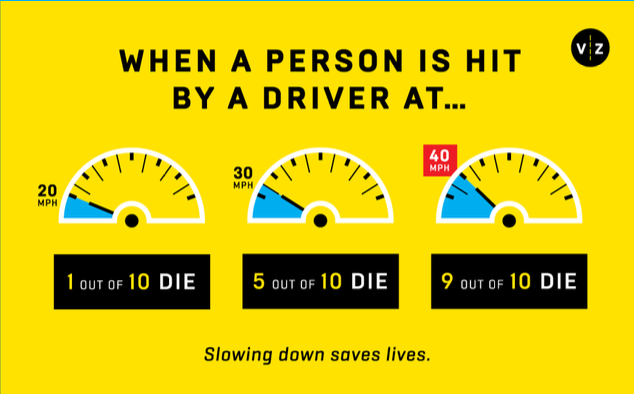
March 07, 2017
 Source/Philadelphia Vision Zero Task Force
Source/Philadelphia Vision Zero Task Force
An image of a roadside memorial appears in the City of Philadelphia's 'Vision Zero Task Force Action Plan.'
On Tuesday, Mayor Jim Kenney released a draft of the city’s "Vision Zero Action Plan," which is billed as a document to guide Philadelphia in its efforts to eliminate traffic-related fatalities and reduce injuries.
The global initiative – which started nearly 20 years ago in Sweden – entered the mayoral-campaign conversation prior to the election of Kenney, who would embrace it as part of his administration’s mission.
Last November, he signed an executive order creating a Vision Zero Task Force to develop a plan to reduce the number of traffic-related deaths to zero by 2030.
“I recognize that traffic crashes resulting in lives lost or severe injuries are preventable incidents,” Kenney said. “It is our shared responsibility to build a transportation system that prioritizes safety on our streets. By focusing on system-wide improvements, we can stop traffic-related deaths. We can save lives.”
While that goal may seem unachievable, the action plan released Tuesday is the latest step in working toward that result.
The city is seeking feedback from “residents, commuters and stakeholders” before releasing the final action plan this fall. You can read the entire report via this link.
Here are 18 highlights of from the draft plan's recommendations:
1. Implement prioritized Safe Routes to School safety improvement projects at six high pedestrian crash district schools.
2. Conduct crash analysis on crashes during school arrival/dismissal hours within one-quarter mile of schools.
3. Develop neighborhood slow-zones program that slow speeds to ensure the safety of the most vulnerable roadway users (seniors, children, and people walking and bicycling).
4. Expand Safe Routes Philly in order to provide education to children, parents and teachers about safely walking and biking to and from school. Develop a volunteer Street Ambassador program that promotes traffic safety in neighborhoods and along high crash corridors.
5. Work with City Council to draft legislation authorizing the Chief Traffic Engineer to implement traffic calming and traffic safety improvements through changes to road markings, signage, and lane configuration that can be justified based on a formal review of crash data and relevant engineering characteristics of subject intersections and roadway segment.
6. Study the implications of instituting strict laws for injuring or killing pedestrians or cyclists within the right of way, similar to New York City’s Administrative Code 19-190, which creates a criminal misdemeanor penalty for these offenders.
7. Install:
• 25 low-cost safety improvements, including new road markings, signs, and minor signal modifications per year
• Pedestrian countdown timers at 13 intersections per year
• A network of protected bicycle lanes to provide a safer active transportation option; pursue funding to enhance temporary protected bike lane strategies with more permanent, high quality strategies such as curbs and planters.
8. Increase enforcement against:
• Illegal parking in school zones and drop-off lanes during school hours
• Illegal passing of school buses
• Illegal sidewalk closures and obstructions
• Both short-term and long-term bicycle lane blockages
9. Develop:
• A centralized crash data repository system for internal use, with the Philadelphia Police Department providing access to needed information from traffic crashes on a recurring basis
• An interactive user-friendly, web-based application for the public to access recent and archived traffic crash statistics
• A Citizens Planning Institute (CPI) "Vision Zero" elective course.
10. Continue to evaluate and install more or relocate Automatic Red Light Enforcement (ARLE) cameras as needed.
11. Create a database of streets and intersections with line-of-sight issues by collecting and tracking input from the public, city employees and partner agencies.
The Vision Zero Task Force's draft report includes data such as that which was included this graphic.
12. Form a Crash Analysis Team from all departments to work with PennDOT and PPD crash data.
13. Integrate Vision Zero curriculum into the Police Academy curriculum and in-service training for police officers
14. Establish enhanced traffic safety enforcement campaign at the precinct level against the most common offenses that result in serious injuries or fatal crashes.
15. Work with State Police to either modify or ensure that behavior information is collected on crash report forms.
16. Work with communication and behavioral science experts to create a public education campaign around Vision Zero.
17. Initiate pilot camera program to explore informing traffic safety interventions with video surveillance.
18. Conduct research to better understand the economic impacts of Vision Zero and Complete Streets.
The city seeks feedback about these, and other, recommendations made in the draft report via a survey on VisionZeroPHL.com.
 Graphic from Vision Zero Task Force draft report/for PhillyVoice
Graphic from Vision Zero Task Force draft report/for PhillyVoice